12 Best Sentiment Analysis Tools I'd Actually Use in 2025
Stop guessing. Here are the 12 best sentiment analysis tools a founder would actually use to decode customer feedback. No fluff, just what works.
Posted by
Related reading
Your Customers Are Telling You How to Beat Your Competitors, but You're Not Listening
What is text analytics? A blunt guide for founders on turning messy customer feedback into a data-driven roadmap for growth and revenue.
Your Customers Are Screaming at You. Are You Even Listening?
Discover the sentiment analysis techniques that turn customer feedback into a competitive advantage. A practical, no-fluff guide for founders.
Your Survey Data Analysis is a Waste of Time
Stop guessing and start growing. This guide to survey data analysis cuts the fluff and reveals the unfiltered methods that drive real startup growth.
Your customers are screaming at you. Not with angry emails—that’s just the tip of the iceberg. They’re whispering in Reddit threads, sighing in support tickets, and casually mentioning deal-breakers in app store reviews. You think your NPS score tells you the whole story? That’s like judging a restaurant by its Yelp rating alone. It’s vanity. Real insight is buried in the unstructured, messy, raw feedback you’re probably ignoring. You’re drowning in data but starving for wisdom. And every minute you spend on another useless survey is a minute a competitor is using to actually understand what people want.
Let’s cut the crap. You don’t need more feedback; you need to understand the feedback you already have. This isn’t a guide for academics. It’s a founder-to-founder breakdown of the best sentiment analysis tools that turn customer noise into a roadmap for not going broke. We’ve done the painful work of digging through these platforms so you don’t have to. For each tool, you'll get a no-fluff breakdown of its core features, ideal use cases, pricing reality, and the honest pros and cons. We include screenshots and direct links to get you started immediately.
Beyond just individual sentiment tools, many businesses benefit from comprehensive social listening platforms to gain deeper market intelligence. You can further explore other platforms, including some of the leading social listening tools for B2B, to see how they bundle sentiment analysis with broader monitoring capabilities.
This list is your shortcut. It compares everything from developer-focused APIs like Google Cloud Natural Language to integrated platforms like Brandwatch, so you can find the right weapon for your specific battle. Read this, pick one, and get back to building something people will pay for.
1. Backsy.ai
If you think your current feedback system is working, you're probably lying to yourself. Standard surveys with star ratings and pre-written questions are the business equivalent of asking someone "How are you?" and expecting a real answer. They're designed to make you feel good, not to tell you the truth. Backsy.ai is built on the opposite premise: stop guiding customers and just let them talk. It scraps the rigid forms for open-ended text and voice feedback, capturing the raw, unfiltered opinions you actually need to hear.
This approach is fundamentally different. Instead of boxing users into your assumptions, it creates a channel for genuine sentiment. The platform then takes this messy, unstructured data from multiple sources (like QR codes at an event or a link in an email) and does the heavy lifting. Its AI automatically filters out the garbage-spam, emoji-only replies, and irrelevant comments-so your team only sees what matters. This is a critical distinction from other tools where you're often left manually cleaning data, a soul-crushing task that kills momentum.
Why It's Our Top Pick
Backsy.ai isn't just another analytics dashboard; it’s a direct line to the customer's brain. For product managers, this means no more guessing games about which feature is causing friction. For restaurant owners, it’s understanding why lunch sales are down, not just that they are. The platform excels at thematic analysis, automatically grouping feedback into recurring topics like "slow service," "buggy checkout," or "love the new packaging." This makes it one of the best sentiment analysis tools for teams who need to move fast and fix real problems, not just admire charts.
The interface is clean and immediately actionable, highlighting what customers love, hate, or are confused about. This isn't about complex NLP models you need a data scientist to decipher. It’s about getting a clear signal from the noise, fast.
Key Takeaway: Ignore your customers, and you’ll be lucky to survive the quarter. Backsy.ai ensures you're not just hearing them, but actually understanding them.
Best For: SaaS founders, product managers, restaurant operators, and anyone who needs honest, actionable feedback without the traditional survey fluff.
| Feature Highlights | Practical Application |
|---|---|
| Unstructured Feedback | Let customers rant or rave via text/voice. Captures emotion you miss with 1-5 scales. |
| AI-Powered Filtering | Automatically removes spam and noise. Your team's time is spent on insights, not data cleaning. |
| One-Click Aggregation | Pulls feedback from all your channels into one dashboard. No more siloed data. |
| Intuitive Dashboards | Instantly see recurring themes, sentiment trends, and direct quotes. |
Pros:
- Gathers authentic, open-ended feedback that reveals a customer's true feelings.
- Saves significant time by automatically cleaning and categorizing raw feedback.
- Centralizes customer voice from disparate channels into a single source of truth.
- A "forever free" tier makes it accessible for early-stage projects and startups.
Cons:
- Feedback cannot be deleted, which could be a data governance issue for some organizations.
- The credit-based system means costs can escalate with very high feedback volume.
Stop building a product nobody wants and start listening to what your customers are screaming at you by trying Backsy.
2. Amazon Comprehend (AWS)
If you're already in the AWS ecosystem, ignoring Amazon Comprehend is like living in a house and refusing to use the kitchen. It’s a fully managed, battle-tested NLP service that plugs directly into your existing infrastructure. Don’t mistake it for a toy; this is an enterprise-grade engine designed for high-volume workloads, from analyzing millions of product reviews to processing real-time social media streams.
What separates Comprehend is its Targeted Sentiment feature. It goes beyond a simple positive/negative score for an entire document. It can tell you what entities (like your brand, product, or a specific feature) customers are talking about and how they feel about each one individually. Forget generic feedback; this tells you customers love your new UI but hate the onboarding flow.
Use Cases & Implementation
Comprehend is a developer’s tool first. You use API calls to integrate it directly into your applications, data lakes, or analytics pipelines. It’s not a fancy dashboard you log into; it’s the raw processing power behind the dashboard you build.
- Best For: Teams with engineers already using AWS. Ideal for processing large, unstructured text datasets for Voice of Customer (VoC) analysis, social media monitoring, and brand reputation management.
- Pricing: Pay-as-you-go. The 12-month free tier is generous for prototyping. After that, pricing is per 100 characters.
- Pro Tip: Real-time analysis endpoints are billed for the entire time they are deployed, not just when processing requests. Use batch jobs from S3 to avoid that cost.
Website: https://aws.amazon.com/comprehend/
3. Google Cloud Natural Language API
If AWS is the enterprise kitchen, Google Cloud’s Natural Language API is the high-tech, modular ghost kitchen built for speed. It’s a dead-simple REST API that delivers powerful NLP capabilities without the infrastructure overhead. For founders who just want to plug in and get accurate sentiment scores without becoming machine learning experts, this is your weapon.
Google’s strength is its Entity Sentiment Analysis, which is brutally effective. It doesn’t just tell you a review is negative; it pinpoints that customers hate the "battery life" (entity) but love the "screen brightness" (another entity) within the same block of text. This granularity is a game-changer for product roadmapping. The API's AnnotateText method is also incredibly efficient, bundling requests for sentiment, entities, and syntax analysis into a single API call.
Use Cases & Implementation
This API is built for developers who need to quickly integrate NLP features into their products. You send a JSON request with your text and get a structured JSON response back. It’s a "black box" solution that just works. For a deeper understanding of the core concepts, you can explore more about the fundamentals of natural language processing.
- Best For: Startups and dev teams needing a fast, scalable, and low-maintenance API for product review analysis, content moderation, and customer support ticket classification.
- Pricing: Pay-as-you-go. The first 5,000 units per month are free, making it a no-brainer for early-stage projects.
- Pro Tip: Use the
AnnotateTextendpoint to combine multiple analyses into one call. It's more efficient and can be cheaper than making separate API calls for each feature.
Website: https://cloud.google.com/natural-language/
4. Microsoft Azure AI Language (Text Analytics)
For organizations deeply invested in the Microsoft stack, Azure AI Language is the native choice. It’s an enterprise-first NLP service designed for security, compliance, and flexible deployment. Don't think of it as just another API; it's a powerful engine built to handle sensitive data in highly regulated industries, offering deployment options that few competitors can match.
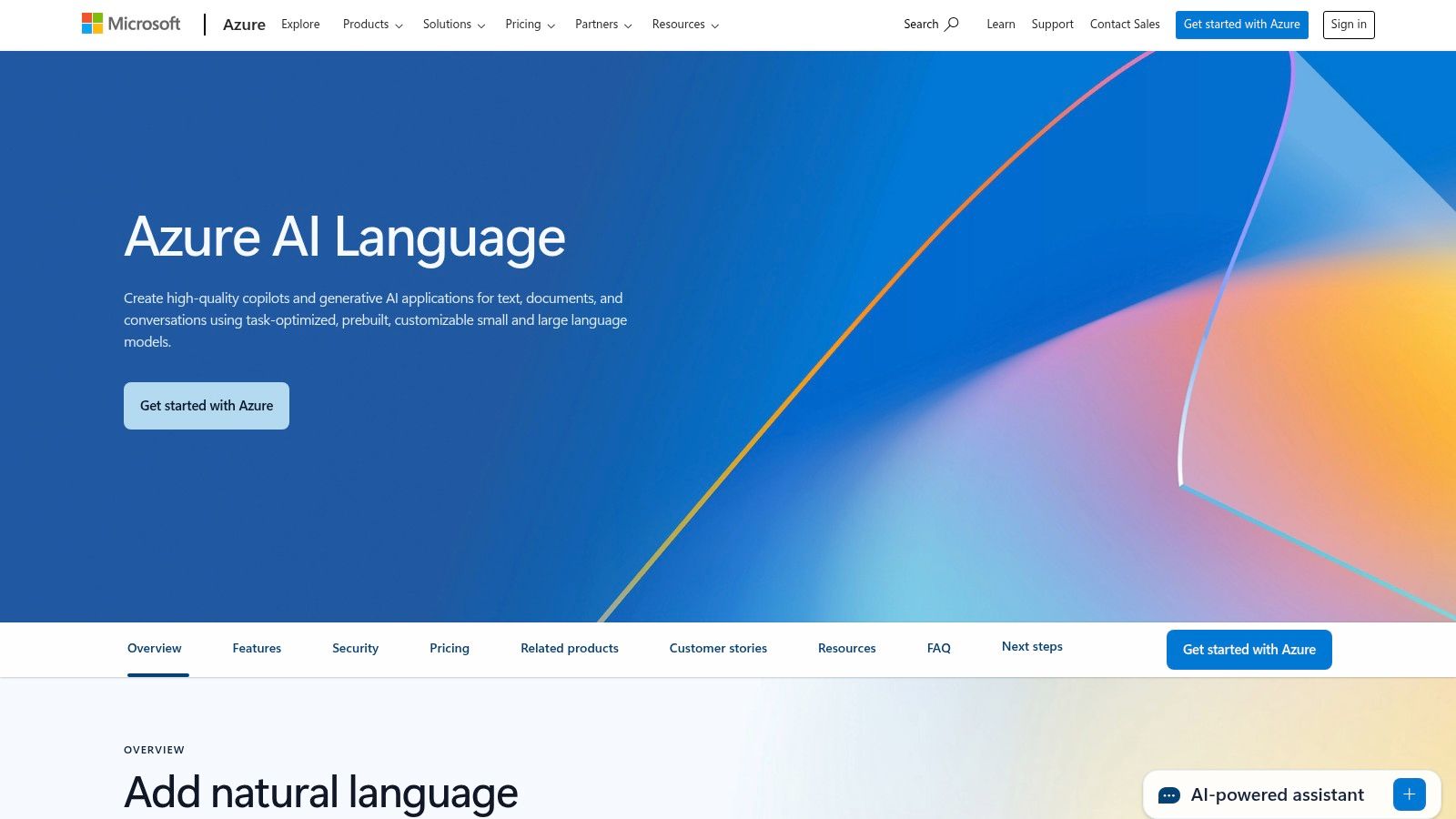
Azure’s key differentiator is its opinion mining and containerized deployment. Opinion mining moves beyond a simple "positive" or "negative" label, pinpointing specific attributes and the sentiment attached to them. This tells you not just that a customer review is negative, but that they found the "battery life" (attribute) to be "terrible" (sentiment). The ability to run this analysis in a container on your own servers is a game-changer for healthcare or finance companies that can't send customer data to the cloud.
Use Cases & Implementation
Like its AWS counterpart, Azure AI Language is a developer-centric tool accessed via API. You integrate it into your apps or data workflows rather than using a pre-built dashboard.
- Best For: Enterprise teams with strict security or data residency requirements, especially those already using Azure. Ideal for analyzing sensitive customer feedback, support tickets, and internal documents.
- Pricing: A pay-as-you-go model with a generous free tier offering 5,000 text records per month.
- Pro Tip: Take advantage of the container support if data privacy is a primary concern. This allows you to leverage Azure’s powerful models without your data ever leaving your infrastructure.
Website: https://azure.microsoft.com/en-us/products/ai-services/ai-language/
5. IBM Watson Natural Language Understanding
If you think all NLP APIs are just clones of each other, you haven’t met Watson. IBM’s offering is less of a raw component and more of a refined linguistic toolset. It's a powerhouse for teams that need to go beyond basic positive/negative scores and dive into the emotional context of customer feedback. For SaaS founders trying to understand user frustration or hospitality brands gauging guest delight, this isn't just a nice-to-have; it's a competitive edge.
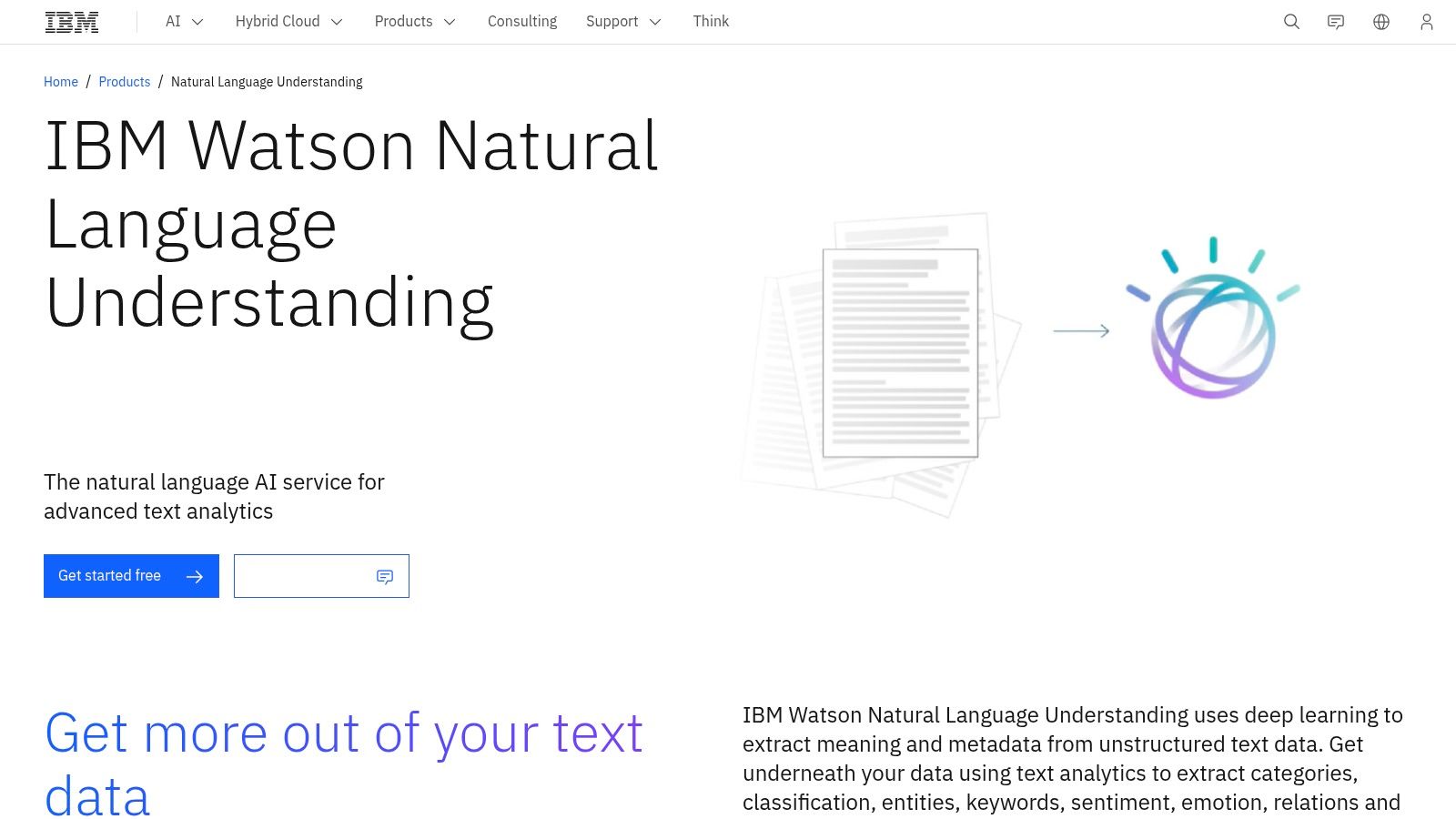
What makes Watson stand out is its native Emotion Analysis. While other tools tell you a customer is "negative," Watson can tell you if they're angry, sad, or disgusted. This level of emotional granularity is gold. It helps you distinguish between a mildly annoyed user who found a bug and an enraged customer on the verge of churning.
Use Cases & Implementation
Like other major cloud providers, Watson is developer-centric, accessed via API, and designed for integration into custom applications and data pipelines. It's not a ready-made dashboard but the engine that powers one.
- Best For: Product managers and support teams who need to understand the emotional drivers behind user feedback. Excellent for developers looking for a generous free tier to build a proof-of-concept.
- Pricing: The Lite plan is a standout, offering a perpetual free tier with 30,000 NLU items per month.
- Pro Tip: Use the Emotion Analysis feature to automatically tag and route support tickets. A ticket showing high "anger" and "sadness" scores should be escalated immediately, long before it becomes a public complaint.
Website: https://www.ibm.com/products/natural-language-understanding
6. Lexalytics Semantria (by Lexalytics/InMoment)
For founders who find off-the-shelf sentiment analysis too blunt, Lexalytics Semantria is the surgical tool in a world of sledgehammers. This isn't your plug-and-play API for a weekend project; it's an enterprise-grade engine designed for extreme customization. If you’re a med-tech company, you need a model that understands the difference between a patient "feeling negative" and a "negative test result." Lexalytics gets that.
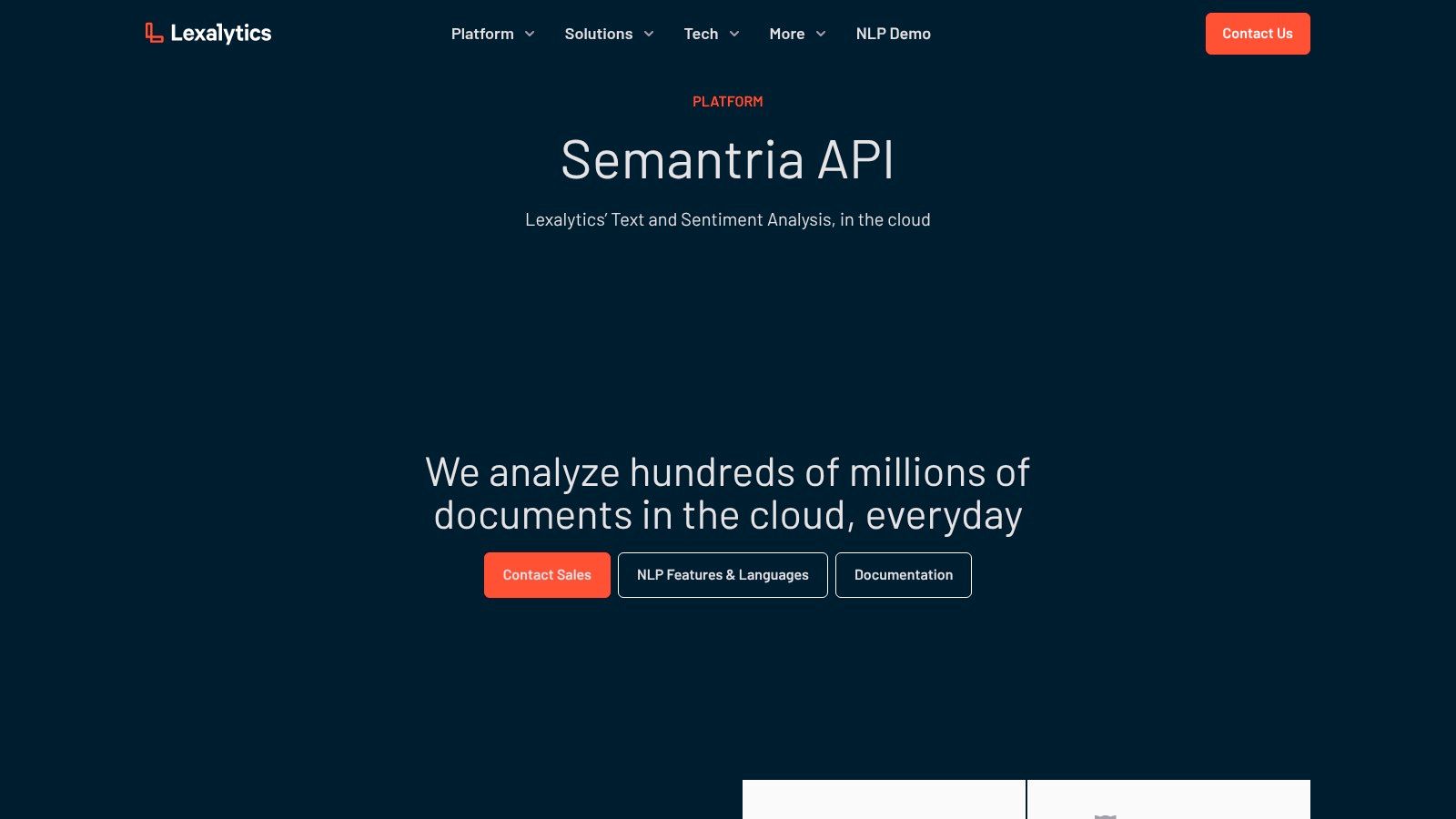
What makes Semantria one of the best sentiment analysis tools is its deployment flexibility. You can use their cloud API, deploy their Salience engine on-premises for maximum data control, or even run it through an Excel add-in. This hybrid approach is critical for industries like finance or healthcare with strict data residency and compliance requirements. Their professional services team will even help you build a custom sentiment model tuned to your specific jargon.
Use Cases & Implementation
Lexalytics is built for complex, high-stakes environments where nuance is everything. Implementation is an involved, sales-led process focused on tailoring the solution to your exact needs.
- Best For: Enterprise teams in regulated or specialized industries (healthcare, finance, legal) that require deep model customization and have specific data security protocols.
- Pricing: Quote-based. You’ll need to contact their sales team. This model is built for serious investment, not casual experimentation.
- Pro Tip: Leverage their industry packs from day one. Trying to teach a generic model the specifics of pharmaceutical trials is a waste of your team's time.
Website: https://www.lexalytics.com/semantria
7. MeaningCloud
If you want text analytics without the vendor-lock of a major cloud provider, MeaningCloud is your answer. It’s a dedicated, API-first text analytics suite that treats sentiment analysis as a core function, not an add-on. Its biggest differentiator isn't raw power but transparency and specialization. While bigger platforms offer a massive toolbox, MeaningCloud gives you a specialized set of surgical instruments with clear, predictable costs.
What makes MeaningCloud stand out are its Vertical Packs. Instead of relying on a generic model, you can plug in industry-specific models for Voice of Customer, Finance, or even detailed Emotion analysis right out of the box. This drastically reduces the time needed to get valuable, domain-specific insights. It's about getting to the so what faster.
Use Cases & Implementation
MeaningCloud is built for developers to integrate via a straightforward REST API. The clear documentation and generous free tier make it easy to prototype and test before committing. It offers both SaaS and on-premises deployment, providing flexibility for companies with strict data requirements.
- Best For: Startups and mid-sized companies needing a powerful, developer-friendly API without committing to a single cloud ecosystem.
- Pricing: A transparent, credit-based subscription model. A free plan includes 20,000 credits per month.
- Pro Tip: Pay close attention to the credit consumption rules. Different languages and analysis types consume credits at different rates, so model your expected usage carefully.
Website: https://www.meaningcloud.com/products/pricing
8. Hugging Face (Inference Providers & Inference API)
Think of Hugging Face not as a single tool, but as a massive, open-source armory for NLP. If pre-packaged solutions feel too restrictive, this is your playground. It’s the de facto standard for the machine learning community, offering a vast repository of pre-trained models you can deploy in minutes. For founders who want to experiment with bleeding-edge sentiment classifiers without spinning up a single server, Hugging Face’s Inference API is a godsend.
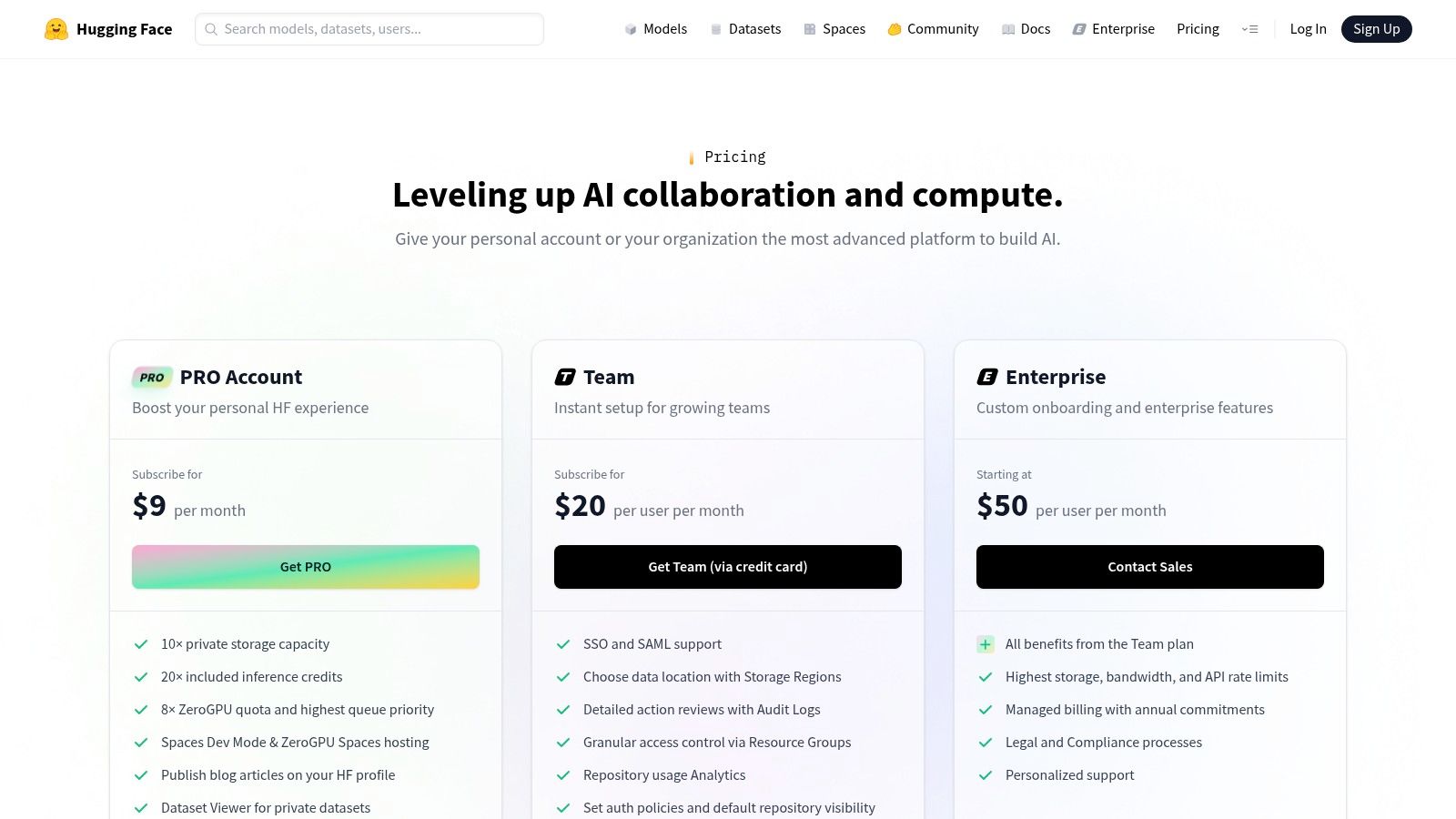
What makes Hugging Face one of the best sentiment analysis tools is the sheer optionality and control it provides. You aren't locked into one company's black-box model. You can test a dozen different sentiment analysis models in an afternoon, find one fine-tuned for your specific domain (like financial news or tweets), and get it running with a simple API call.
Use Cases & Implementation
Hugging Face is for builders. You grab a model from the Hub and call it via the Inference API. For prototyping, the serverless API is perfect. As you scale and need more consistent performance, you can upgrade to dedicated Inference Endpoints, which gives you reserved hardware without the DevOps headache.
- Best For: Technically-inclined teams, data scientists, and developers who want to rapidly prototype and deploy custom or specialized sentiment analysis models without managing infrastructure.
- Pricing: A generous free tier offers up to 30k input characters for serverless inference. Paid plans are based on compute time and hardware.
- Pro Tip: Don't just stick to the most popular models. Use the platform’s filtering to find models specifically trained on datasets relevant to your industry (e.g.,
twitter-roberta-base-sentiment). The results will be dramatically better.
Website: https://huggingface.co/pricing
9. Twinword API (Sentiment Analysis and related NLP)
If the enterprise-level price tags on major NLP platforms make you sweat, Twinword API is your entry point. It’s a collection of lean, effective, and incredibly affordable NLP APIs built for developers, startups, and small teams who need to add sentiment analysis to an app or prototype without selling a kidney. It’s the perfect tool for when "good enough" is exactly what you need to validate an idea.
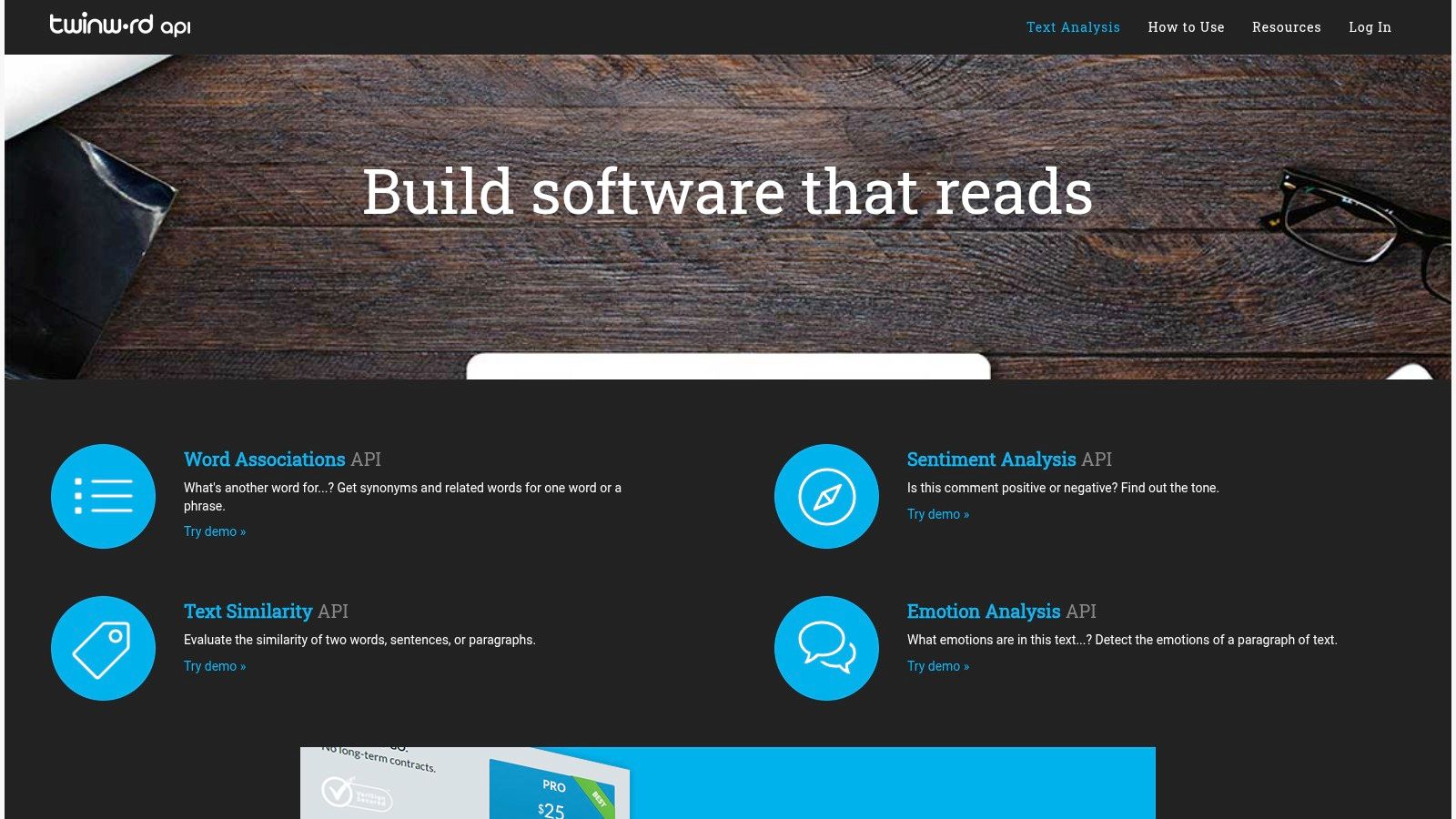
What makes Twinword stand out is its dead-simple implementation and flexible, almost ridiculously cheap pricing. While it offers sentiment analysis, its toolkit also includes emotion analysis and text similarity, which are often bundled into much more expensive packages elsewhere. This allows a startup founder to not just see if a review is positive or negative, but also detect if the customer is joyful, angry, or sad, adding a crucial layer of context without a complex setup.
Use Cases & Implementation
This is a pure API play, meaning your developers will be making direct calls to get back structured JSON data. It’s designed for easy integration into smaller applications, scripts, or marketing automation workflows. Don’t expect a fancy dashboard; expect a functional endpoint that gets the job done.
- Best For: Startups, indie developers, and marketing teams needing to add NLP features to small apps or build prototypes on a tight budget.
- Pricing: Extremely generous free tier with 500 API calls per month. Paid plans start as low as $19/month for 200,000 calls.
- Pro Tip: Use the free tier to test out not just sentiment but also the emotion and topic tagging APIs. A combination might provide richer insights than a simple sentiment score alone.
Website: https://www.twinword.com/api/
10. RapidAPI (Marketplace hub for Sentiment APIs)
Think of RapidAPI not as a single tool, but as the App Store for sentiment analysis APIs. Instead of committing to one provider, you get a centralized hub to test, compare, and integrate dozens of different sentiment analysis tools with a single API key and unified billing. This approach kills the vendor lock-in problem before it even starts.
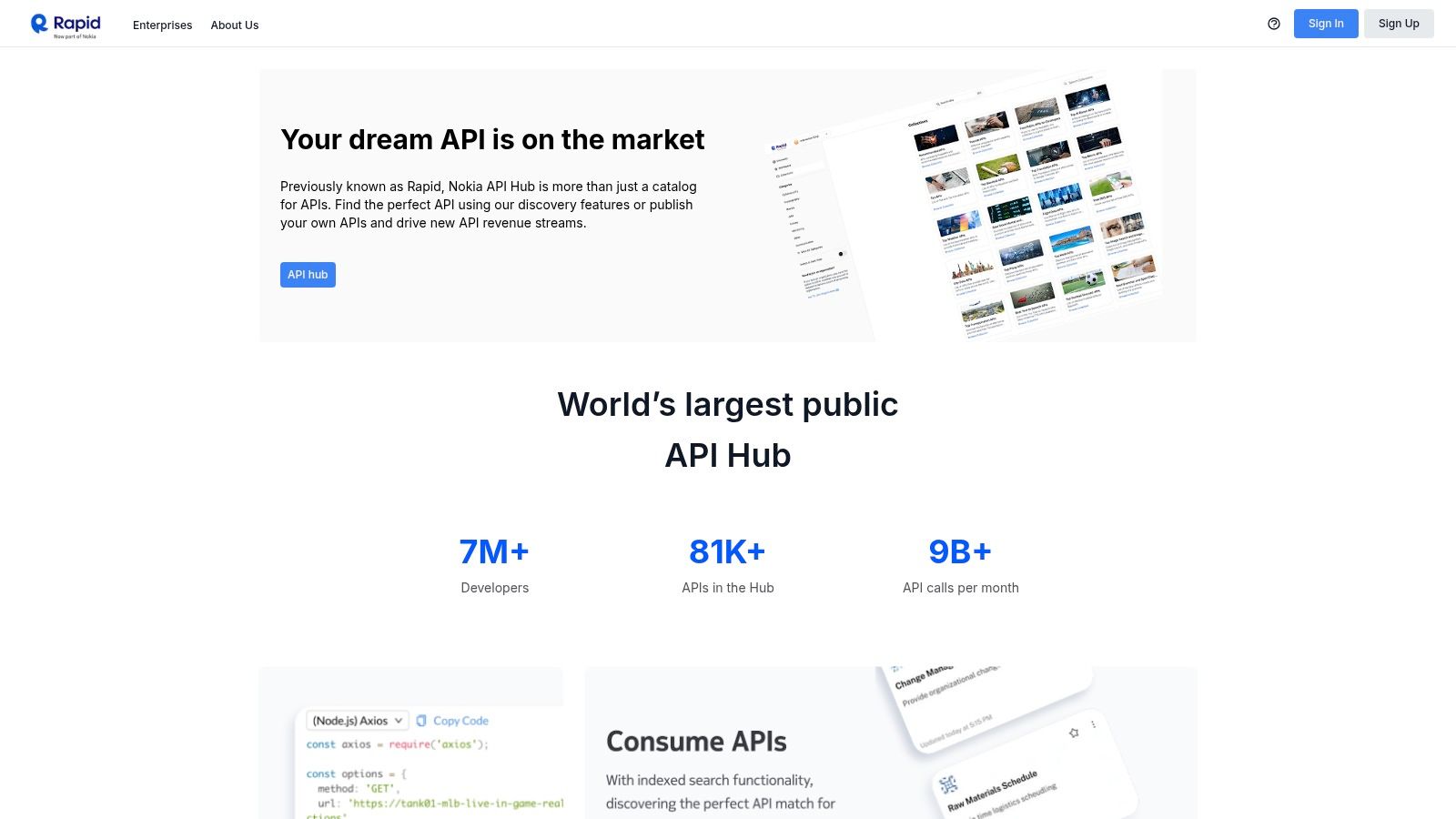
What makes RapidAPI a standout choice is the transparency and speed it offers during prototyping. Each API on the platform displays public metrics for latency, success rate, and popularity, along with user reviews. You can test endpoints directly in your browser, get instant code snippets in your language of choice, and switch providers by changing a single line of code.
Use Cases & Implementation
RapidAPI is built for developers who need to move fast. You find an API, subscribe to a plan (many have free tiers), and use the provided credentials and code snippets to integrate it into your application. It abstracts away the complexity of individual API authentications and documentation styles.
- Best For: Startups and dev teams needing to quickly prototype and compare different sentiment analysis solutions.
- Pricing: Varies entirely by the API provider you choose. RapidAPI manages the billing, but each vendor sets their own freemium, pay-as-you-go, or monthly subscription plans.
- Pro Tip: Pay close attention to the user reviews and the "Popularity" score for each API. While the marketplace is convenient, the quality can vary drastically between providers.
Website: https://rapidapi.com/
11. Brandwatch Consumer Research
If you’re running a CPG brand or a marketing agency, flying blind on social media sentiment is a death wish. Brandwatch is the enterprise-grade listening post you set up to monitor the entire battlefield. It’s not just another social media tool; it’s a consumer intelligence engine built to tap into over 90 million data sources in real-time. Forget wondering what people think; Brandwatch tells you.
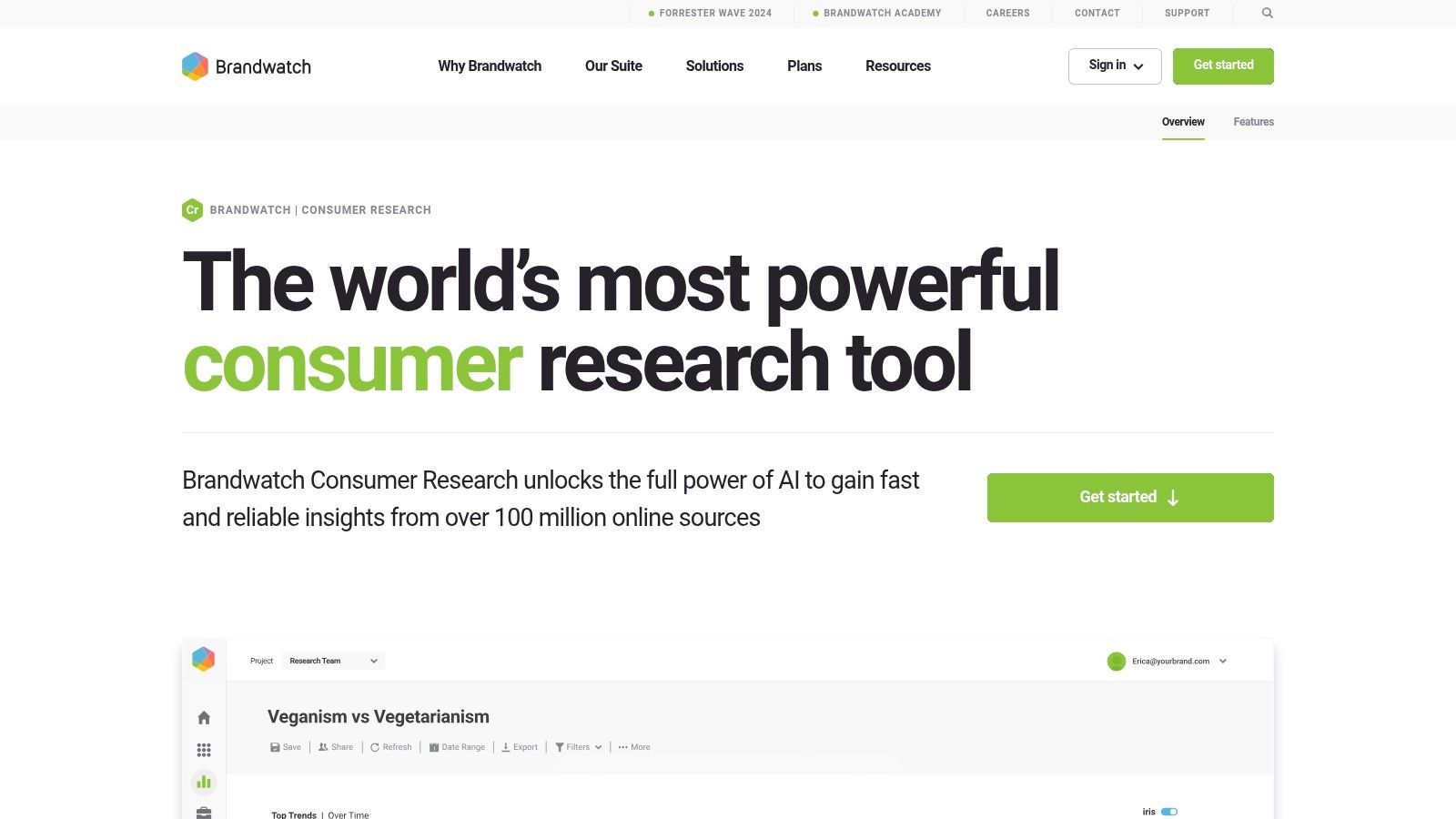
What makes Brandwatch one of the best sentiment analysis tools is its sheer scale and reliability. While other tools give you a snapshot, Brandwatch provides a panoramic view with historical data access, letting you track sentiment shifts around a product launch or PR crisis. It’s built for teams that need to react fast, with sophisticated alerting and automated reporting that turns raw social chatter into actionable business intelligence. This isn’t a developer API; it’s a full-fledged command center.
Use Cases & Implementation
Brandwatch is a SaaS platform designed for marketing, PR, and consumer insights teams. Implementation is about setup and training, not coding. You configure queries, build dashboards, and set up alerts to monitor brands, competitors, and industry topics.
- Best For: Enterprise marketing and communications teams needing robust social listening, competitor analysis, and brand health tracking. It’s overkill for a small dev team but essential for a global brand.
- Pricing: Not publicly listed. Pricing is enterprise-level and requires a conversation with their sales team.
- Pro Tip: Use the advanced query-building features to filter out irrelevant noise. A poorly constructed query will pull in spam and bot activity, skewing your sentiment data.
Website: https://www.brandwatch.com/products/consumer-research/
12. Hootsuite Insights / Listening (Brandwatch or Talkwalker-powered)
For social media managers, sentiment analysis isn't a separate task; it's part of the daily workflow. Hootsuite gets this. Their Insights and Listening tools, powered by industry heavyweights like Brandwatch and Talkwalker, embed sentiment analysis directly where you manage your social channels. You aren't just analyzing data; you’re positioned to act on it instantly, turning a negative comment into a support ticket or a positive mention into user-generated content without switching tabs.
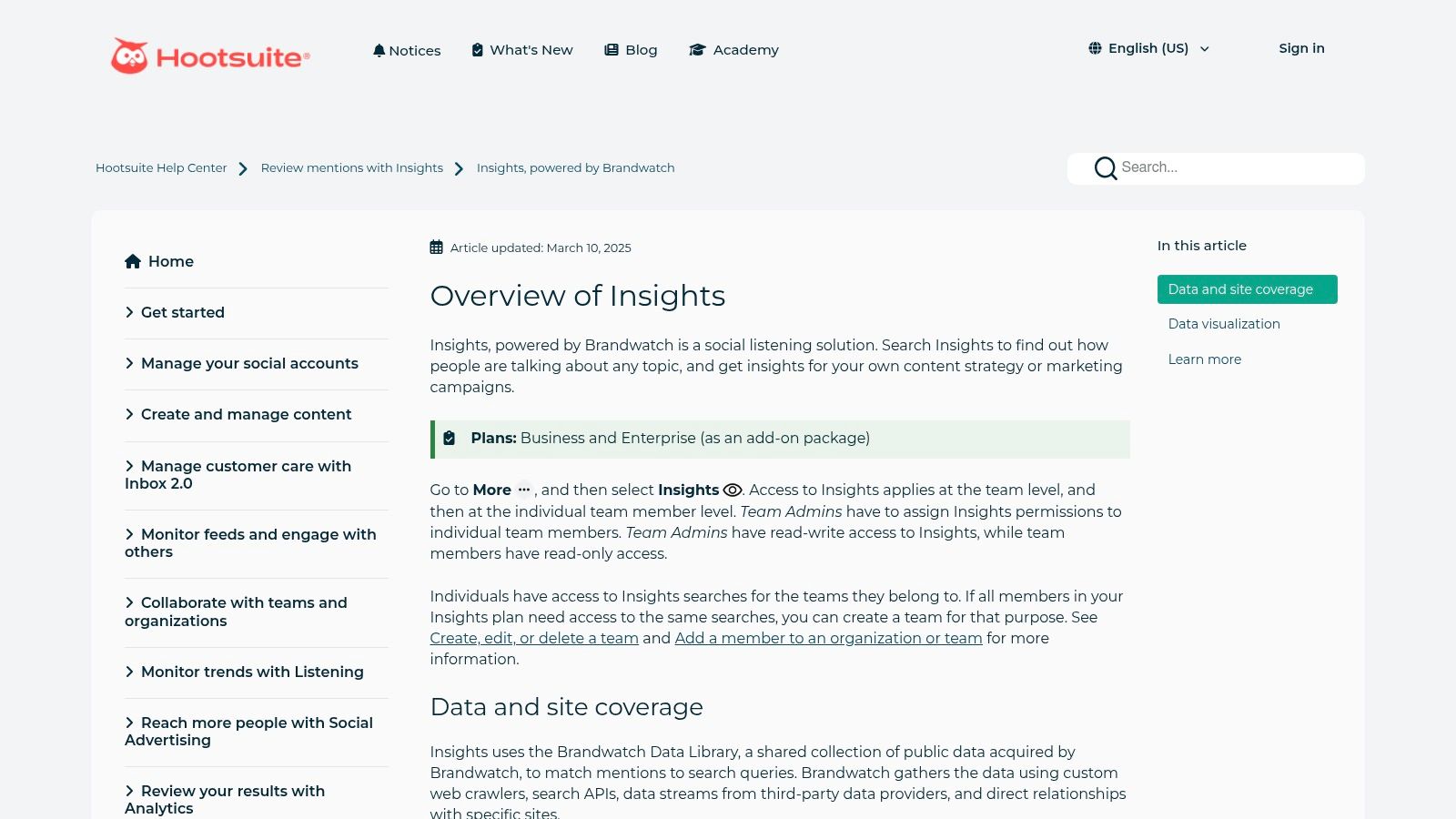
The key differentiator is this tight integration. While many tools give you powerful dashboards, Hootsuite connects the dots between listening, publishing, and engagement. You can see sentiment trends, dive into the mentions driving that trend, and immediately assign a post to a team member. This closed-loop system is designed for teams that need to manage brand reputation in real time, not just report on it quarterly.
Use Cases & Implementation
Hootsuite Insights is a native add-on, meaning it’s built to be used within the platform's ecosystem without complex API work. The setup involves creating monitoring streams and dashboards configured through the Hootsuite interface, making it accessible to non-technical teams.
- Best For: Digital marketing agencies and in-house social media teams that already use Hootsuite for scheduling and engagement. Perfect for campaign monitoring and real-time brand health tracking.
- Pricing: Available as a paid add-on for Hootsuite Business and Enterprise plans. Requires contacting their sales team.
- Pro Tip: Use the alerting feature to get immediate notifications for spikes in negative sentiment. This allows your team to get ahead of a potential crisis before it escalates.
Website: https://help.hootsuite.com/hc/en-us/articles/4402745597467-Overview-of-Insights
Sentiment Analysis Tools Feature Comparison
| Platform | Core Features / Capabilities | User Experience & Quality ★★★★☆ | Value & Pricing 💰 | Target Audience 👥 | Unique Selling Points ✨ |
|---|---|---|---|---|---|
| Backsy.ai 🏆 | AI-powered unstructured text & voice feedback analysis | Intuitive dashboards, spam filtering | Flexible plans incl. free tier 💰 | SMEs, restaurants, SaaS, events | Honest feedback capture, multi-channel, no tech skills needed ✨ |
| Amazon Comprehend (AWS) | Sentiment, entity detection, syntax, language ID | Enterprise-grade, scalable ★★★★ | Per-character pricing, free tier | Enterprises, AWS users | Deep AWS integration, managed endpoints ✨ |
| Google Cloud Natural Language API | Document/entity sentiment, syntax, classification | Simple usage, combines features well ★★★ | Usage-based with free monthly quota | Developers, cloud users | Combined multi-feature API calls |
| Microsoft Azure AI Language (Text Analytics) | Sentiment, opinion mining, NER, PII detection | Enterprise security, flexible deployment ★★★★ | Free 5,000 records/month | Enterprises, regulated industries | On-premise containers, opinion mining |
| IBM Watson Natural Language Understanding | Sentiment & emotion analysis, custom models support | Emotion analysis, free lite plan ★★★ | Item-based pricing, free Lite plan | Enterprises, trial users | Built-in emotion insights |
| Lexalytics Semantria | Deep sentiment tuning, cloud/on-prem, Excel add-in | Highly customizable, enterprise-focused ★★★★ | Sales-driven pricing | Enterprises, domain-specific projects | Industry pack customization, hybrid deployment |
| MeaningCloud | Sentiment API with vertical packs, SaaS & on-prem | Clear tiers, developer-friendly ★★★ | Transparent subscription tiers | Developers, industry-specific projects | Add-on vertical packs for domain acceleration |
| Hugging Face (Inference API) | Access 200+ sentiment models, serverless API | Easy multiple model trials ★★★ | Free & paid inference credits | Developers, researchers | Multi-model marketplace, quick deployment |
| Twinword API | Sentiment, emotion, similarity APIs, free tier | Budget-friendly, simple ★★★ | Low-cost plans, multiple marketplaces | Small apps, prototypes | Multiple billing options, affordable pricing |
| RapidAPI | API marketplace for multiple sentiment/NLP APIs | Centralized trial/testing ★★★ | Per-API pricing, unified billing | Developers needing multiple APIs | One key for many APIs, code snippets |
| Brandwatch Consumer Research | Real-time sentiment on 90M+ sources, dashboards | Mature analysis, enterprise workflows ★★★★ | Sales-based pricing | Marketing, PR teams, enterprises | Extensive social listening, alerts, integrations |
| Hootsuite Insights (Brandwatch/Talkwalker) | Social listening, sentiment, alerts, integrated publishing | Combined listening & publishing ★★★ | Add-on in Business/Enterprise plans | Marketing teams, enterprises | Social + publishing in one, AI summaries |
The Only Metric That Matters is Reality
You've just scrolled through a dozen of the best sentiment analysis tools. If you walk away thinking the goal is to find the prettiest dashboard or the cheapest API, you've already lost. The entire point is to close the gap between what you think your customers feel and what they actually feel. Your NPS score is a vanity metric, a comfortable lie you tell yourself at board meetings. The real gold is buried in the unstructured chaos of your support tickets, App Store reviews, and Slack DMs.
How to Not Screw This Up
You don't need a data science team to get started, but you do need a reality-check framework. Here's how to pick a tool without getting lost in the weeds:
For the "Move Fast and Fix Things" Founder (Non-Technical): Your time is your most valuable asset. Stop pretending you’re going to learn Python this weekend. You need a tool that gives you answers, not more work. Look at platforms like Backsy.ai or Brandwatch. They’re built for strategic insight, not for tinkering. The goal is to spend less than an hour a week and get 80% of the value.
For the "We Have an Engineer for That" Startup (Technical): Your team can handle an API. The question is, should they? Building a custom sentiment analysis pipeline on top of AWS Comprehend or Google Cloud Natural Language is a classic trap. You’re not just paying for the API calls; you're paying your most expensive engineers to build and maintain internal tooling that already exists. Only go this route if you have a truly unique, mission-critical need. For rapid prototyping, an API from RapidAPI or a pre-trained model from Hugging Face is a godsend.
For the "Analyze Everything" Enterprise Marketer: You're swimming in data from social media, surveys, and review sites. Your challenge isn't data collection; it's synthesis. Tools like Hootsuite Insights or Lexalytics are designed to ingest massive datasets and find the signal in the noise. Avoid "analysis paralysis." Pick one or two key feedback channels, connect your tool, and focus on extracting actionable themes, not just generating reports nobody reads.
Your Next Move Determines Your Next Quarter
The biggest mistake founders make is treating customer feedback like a report card. It’s not. It’s a treasure map. It’s a series of clues telling you exactly where to dig to find more revenue, better retention, and a product that actually sells itself.
Ignoring raw, unfiltered customer voice is a slow-motion suicide mission for your company. You'll spend months building features nobody asked for while your churn rate quietly suffocates your growth. Don't be the founder who’s proud of their 9/10 NPS score while their best customers are flocking to a competitor who actually listened. Pick a tool. Hook up your data. And prepare to face reality.
Stop guessing and start building what your customers are already begging you to build with Backsy.ai, the brutally honest VoC tool that turns raw feedback into your next product roadmap.